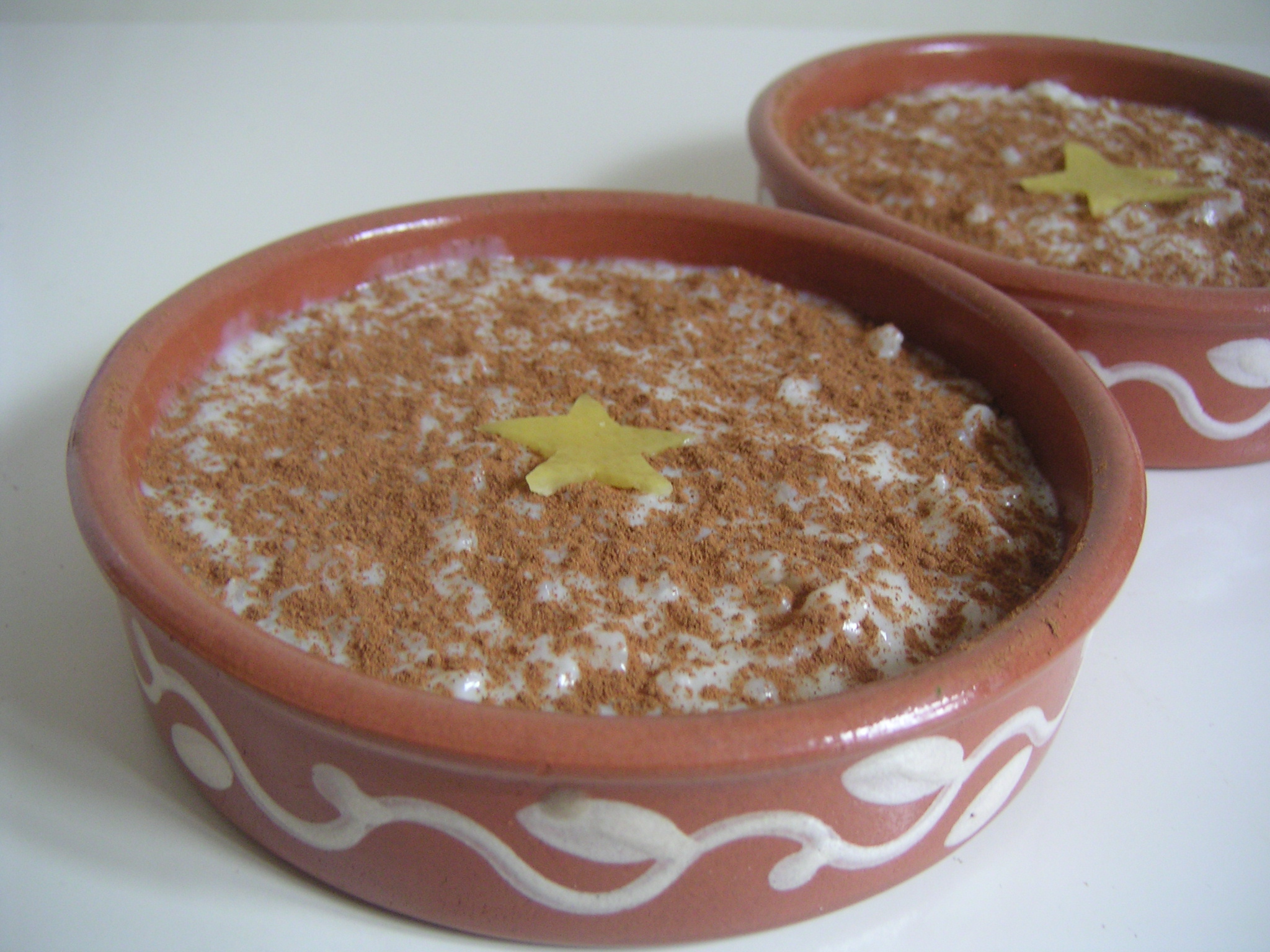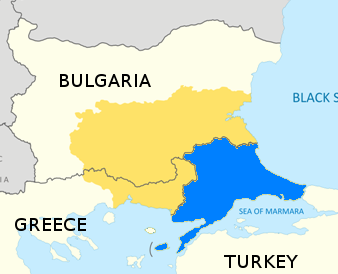|
Zerde
Zerde is a traditional Iraqi, Mesopotamian dessert. The original rice pudding, infused with a generous amount of saffron giving it a vibrant yellow hue and a delicate floral flavour. This is a festive dish popular at weddings, births, and during holy festivities such as the first Sunday of the month of Sha'aban celebrating the birth of the prophet Zechariah, and the first ten days of the sacred month of Muharram. Zer, which means gold and or yellow, comes from Persian zard (زرد) which means yellow. In some regions of Turkey, Zerdeçal Turmeric also added for a more intense colour. Zerde is very popular and has made its way to western Turkey with people immigrating to west at Eastern Thrace, which provides almost the half of country's rice production, zerde is a favored dessert. Flavoring ingredients of zerde vary slightly from region to region in Turkey depending on the local fruits. Zerde differs from rice pudding Rice pudding is a dish made from rice mixed with water ... [...More Info...] [...Related Items...] OR: [Wikipedia] [Google] [Baidu] |
Sholezard
Sholezard (also known as zard birinj or zarda or in Azerbaijani Turkic Sarkilə) is a rice pudding composed of saffron, sugar, rose water, butter, cinnamon and cardamom. It is often made and distributed in substantial quantities in religious ceremonies. SholeZard is a traditional Iranian dessert that is yellow due to the presence of saffron and is topped with cinnamon, almond slices, and pistachio slices. Shellezard is generally cooked in one way, and it is especially used for breaking the fast during the month of Ramadan. Generally, people liken this dessert to jelly. See also *Muhallebi *Kheer * Rice pudding * Zarda (food) Zarda ( ''zardā'', ''zardā'', ''jôrdā'') is a traditional boiled sweet rice dish, native to the Indian subcontinent, made with saffron, milk and sugar, and flavoured with cardamom, raisins, pistachios or almonds. The name 'zarda' comes fr ... * Zerde References External links ''Food & Wine'' – Shole Zard (Saffron Rice Pudding) recipe Iran ... [...More Info...] [...Related Items...] OR: [Wikipedia] [Google] [Baidu] |
Ancient Persia
The history of Iran (also known as Persia) is intertwined with Greater Iran, which is a socio-cultural region encompassing all of the areas that have witnessed significant settlement or influence exerted by the Iranian peoples and the Iranian languages chiefly the Persians and the Persian language. Central to this region is the Iranian plateau, now largely covered by modern Iran. The most pronounced impact of Iranian history can be seen stretching from Anatolia in the west to the Indus Valley in the east, including the Levant, Mesopotamia, the Caucasus, and parts of Central Asia. To varying degrees, it also overlaps or mingles with the histories of many other major civilizations, such as India, China, Greece, Rome, and Egypt. Iran is home to one of the world's oldest continuous major civilizations, with historical and urban settlements dating back to 4000 BC. [...More Info...] [...Related Items...] OR: [Wikipedia] [Google] [Baidu] |
Rice
Rice is a cereal grain and in its Domestication, domesticated form is the staple food of over half of the world's population, particularly in Asia and Africa. Rice is the seed of the grass species ''Oryza sativa'' (Asian rice)—or, much less commonly, ''Oryza glaberrima'' (African rice). Asian rice was domesticated in China some 13,500 to 8,200 years ago; African rice was domesticated in Africa about 3,000 years ago. Rice has become commonplace in many cultures worldwide; in 2023, 800 million tons were produced, placing it third after sugarcane and maize. Only some 8% of rice is traded internationally. China, India, and Indonesia are the largest consumers of rice. A substantial amount of the rice produced in developing nations is lost after harvest through factors such as poor transport and storage. Rice yields can be reduced by pests including insects, rodents, and birds, as well as by weeds, and by List of rice diseases, diseases such as rice blast. Traditional rice polyc ... [...More Info...] [...Related Items...] OR: [Wikipedia] [Google] [Baidu] |
Zarda (food)
Zarda ( ''zardā'', ''zardā'', ''jôrdā'') is a traditional boiled sweet rice dish, native to the Indian subcontinent, made with saffron, milk and sugar, and flavoured with cardamom, raisins, pistachios or almonds. The name 'zarda' comes from Persian word 'zard' meaning 'yellow', because the food coloring added to the rice gives it a yellow color. Zarda is typically served after a meal. In the Indian subcontinent, zarda was and still remains a popular dessert on special occasions such as weddings. It is quite similar to sholezard, a traditional Iranian dessert, and zerde, a traditional Turkish dessert . Often in Pakistan, instead of yellow food coloring, multiple food colorings are added so the rice grains are of multiple colors. Additionally, khoya, candied fruits (murabba) and nuts are an essential part of zarda made at auspicious occasions. There also is a popular use of raisins, and other dried fruits to dish. Dating back to Mughal India, zarda had a variation with ... [...More Info...] [...Related Items...] OR: [Wikipedia] [Google] [Baidu] |
Rice Pudding
Rice pudding is a dish made from rice mixed with water or milk and commonly other ingredients such as sweeteners, spices, flavourings and sometimes eggs. Variants are used for either desserts or dinners. When used as a dessert, it is commonly combined with a sweetener such as sugar. Such desserts are found on many continents, especially Asia, where rice is a staple. Some variants are thickened only with the rice starch, while others include eggs, making them a kind of custard. Rice pudding around the world Rice puddings are found in nearly every area of the world. Recipes can greatly vary even within a single country. The dessert can be boiled or baked. Different types of pudding vary depending on preparation methods and the selected ingredients. The following ingredients are usually found in rice puddings: * rice; white rice (usually short-grain, but can also be long-grain, broken rice, basmati, or jasmine rice), brown rice, or black rice * milk (whole milk, plant milk, cream ... [...More Info...] [...Related Items...] OR: [Wikipedia] [Google] [Baidu] |
Eastern Thrace
East Thrace or Eastern Thrace, also known as Turkish Thrace or European Turkey, is the part of Turkey that is geographically in Southeast Europe. Turkish Thrace accounts for 3.03% of Turkey's land area and 15% of its population. The largest city is Istanbul, which straddles the Bosporus between Europe and Asia. East Thrace is of historic importance as it is next to a major sea trade corridor and constitutes what remains of the once-vast Ottoman Empire, Ottoman region of Rumelia. It is currently also of specific geostrategy, geostrategic importance because the sea corridor, which includes Turkish straits, two narrow straits, provides access to the Mediterranean Sea from the Black Sea for the navies of five countries: Russia, Ukraine, Romania, Bulgaria, and Georgia (country), Georgia. The region also serves as a future connector of existing Turkish, Bulgarian, and Greek high-speed rail networks. Due to the guest worker agreement with Turkey and Germany, some Turks in Germany orig ... [...More Info...] [...Related Items...] OR: [Wikipedia] [Google] [Baidu] |
Turmeric
Turmeric (), or ''Curcuma longa'' (), is a flowering plant in the ginger family Zingiberaceae. It is a perennial, rhizomatous, herbaceous plant native to the Indian subcontinent and Southeast Asia that requires temperatures between and high annual rainfall to thrive. Plants are gathered each year for their rhizomes, some for propagation in the following season and some for consumption or dyeing. The rhizomes can be used fresh, but they are often boiled in water and dried, after which they are ground into a deep orange-yellow shelf-stable spice powder commonly used as a coloring and flavoring agent in many Asian cuisines, especially for curries ( curry powder). Turmeric powder has a warm, bitter, black pepper-like flavor and earthy, mustard-like aroma. Although long used in Ayurvedic medicine, there is no high-quality clinical evidence that consuming turmeric or the principal turmeric constituent, curcumin, is effective for treating any disease. Curcumin, a bright ye ... [...More Info...] [...Related Items...] OR: [Wikipedia] [Google] [Baidu] |
Muharram
Al-Muharram () is the first month of the Islamic calendar. It is one of the four sacred months of the year when warfare is banned. It precedes the month of Safar. The tenth of Muharram is known as Ashura, an important day of commemoration in Islam. For Sunni Muslims, the day marks the parting of the Red Sea by Moses and the salvation of the Israelites, celebrated through supererogatory fasting and other acceptable expressions of joy. By contrast, Ashura is a day of mourning for Shia Muslims, who annually commemorate the death of Husayn ibn Ali, grandson of the Islamic prophet Muhammad and the third Shia imam. Husayn was killed, alongside most of his relatives and his small retinue, in the Battle of Karbala in 680 CE against the army of the Umayyad caliph Yazid ibn Mu'awiya (). The Shia rituals span the first ten days of Muharram, culminating on Ashura with mourning processions in Shia cities. Also in Muharram, the Aqsa mosque in Jerusalem was initially set as the direc ... [...More Info...] [...Related Items...] OR: [Wikipedia] [Google] [Baidu] |
Zechariah In Islam
According to the Islamic doctrine, Zakariyyā (, Zechariah; 97 BCE – 33 CE) is a prophet of God, and the father of the prophet Yahya. In the Quran According to the Quran, Zakariya was said to be a priest''Lives of the Prophets'', Leila Azzam, ''Zacharias and John'' and prophet of God whose office was in the Second Temple in Jerusalem. He would frequently be in charge of managing the services of the temple and he would always remain steadfast in prayer to Allah. Praying for a son As he reached his old age, Zakariya began to worry over who would continue the legacy of preaching the message of God after his death and who would carry on the daily services of the temple after him. Zakariya started to pray to God for a son. The praying for the birth of an offspring was not merely out of the desire for a child. He prayed both for himself and for the public – they needed a messenger, a man of God who would work in the service of the Lord after Zakariya. Zakariya had characte ... [...More Info...] [...Related Items...] OR: [Wikipedia] [Google] [Baidu] |
Pudding
Pudding is a type of food which can either be a dessert served after the main meal or a Savoury (dish), savoury (salty or sweet, and spicy) dish, served as part of the main meal. In the United States, ''pudding'' means a sweet, milk-based dessert similar in consistency to egg-based custards, Bird's Custard, instant custards or a mousse, often commercially set using cornstarch, gelatin or similar coagulating agent. The modern American meaning of pudding as dessert has evolved from the original almost exclusive use of the term to describe savoury dishes, specifically those created using a process similar to that used for sausages, in which meat and other ingredients in mostly liquid form are encased and then steamed or boiled to set the contents. In the United Kingdom, Republic of Ireland, Ireland and some Commonwealth of Nations, Commonwealth countries, the word ''pudding'' is used to describe sweet and Savoury (dish), savoury dishes. Savoury puddings include Yorkshire pudding ... [...More Info...] [...Related Items...] OR: [Wikipedia] [Google] [Baidu] |
Dessert
Dessert is a course (food), course that concludes a meal; the course consists of sweet foods, such as cake, biscuit, ice cream, and possibly a beverage, such as dessert wine or liqueur. Some cultures sweeten foods that are more commonly umami, savory to create desserts. In some parts of the world, there is no tradition of a dessert course to conclude a meal. Historically, the dessert course consisted entirely of foods 'from the storeroom' (''de l’office''), including fresh, stewed, preserved, and dried fruits; nuts; cheese and other dairy dishes; Cookie, dry biscuits (cookies) and wafers; and ices and Ice cream, ice creams. Sweet dishes from the kitchen, such as freshly prepared pastries, meringues, custards, puddings, and baked fruits, were served in the Entremet, entremets course, not in the dessert course. By the 20th century, though, sweet entremets had come to be included among the desserts. The modern term ''dessert'' can apply to many sweets, including fruit, custard ... [...More Info...] [...Related Items...] OR: [Wikipedia] [Google] [Baidu] |





